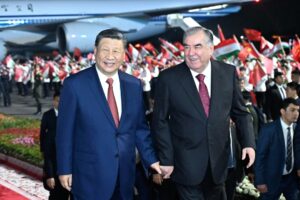An analysis of declassified US government documents shows what Bill Clinton’s administration got right and wrong about the Bosnian war – and how it agonised about lifting the arms embargo and using air strikes against the Serbs.
More than 300 documents on Bosnia and Herzegovina released by the Clinton Presidential Library are a trove of declassified information that represents a rich resource for historians and political scientists studying the US response to the 1992-95 war in Bosnia.
While many of them are redacted and many others probably yet to be declassified, it is still possible to get a glimpse into how US government agencies viewed the collapse of Yugoslavia and the war in Bosnia.
Now, from a historical distance of three decades, it is possible to analyse these documents. A particularly interesting question is how the various intelligence predictions about the situation in Bosnia measured up to what actually happened.
The first document in this series is a US National Intelligence Estimate from 1990. It was prescient about Yugoslavia’s bleak outlook, predicting that “within a year the federal system will no longer exist; within two years Yugoslavia will probably have dissolved as a state”. It further predicted that neither the Yugoslav People’s Army, JNA nor the Communist Party would sustain Yugoslavia.
Though then Yugoslav Prime Minister Ante Markovic attempted economic reforms, the National Intelligence Estimate predicted that these reforms would not succeed in keeping Yugoslavia intact. It presciently foresaw what would unfold: “The Serbs, however, will attempt to foment uprisings by Serb minorities elsewhere – particularly in Croatia and Bosnia-Hercegovina – and large-scale ethnic violence is likely.” The document further predicted that “Serbian repression in Kosovo will result in an armed uprising by the majority Albanian population”.
As for the US response, the National Intelligence Estimate stated that there was little the US could do to keep Yugoslavia together and that the Europeans, too, would go along with the country’s dissolution.
In March 1991, an Intelligence Assessment concluded that “Yugoslavia’s political fabric is badly frayed and may unravel in 1991”. The document further predicted that the JNA would fall apart along ethnic lines and would turn into an essentially Serbian military force.
At the end of 1991, a CIA Directorate of Intelligence Memorandum titled “Bosnia-Hercegovina: On the Edge of the Abyss” dated December 19, 1991 was particularly pessimistic but prescient about the unfolding situation. It noted that Bosnia was a mini-Yugoslavia with its ethnic make-up, and after Bosnian Serb representatives left its parliament in October 1991, the government functioned “sporadically”.
The memorandum stated that Bosnia’s President Alija Izetbegovic was a “moderate Muslim” who “worked to promote a general settlement that would hold Yugoslavia together and keep Bosnia-Hercegovina out of the fighting.”
It further noted however that “Izetbegovic and other moderates now see events slipping out of their control. In addition to the breakdown of the republic’s carefully constructed coalition government, a similar process is underway in what remains of Bosnia-Hercegovina’s Territorial Defence Forces.” The memorandum said that Izetbegovic faced the choice of remaining in a rump Yugoslavia or proceeding with Bosnia’s independence, which could trigger a war.
The memorandum predicted what would happen if violence erupted, saying that “the Serbs will have the support of local JNA commanders. We believe that Serb irregular units have received arms and ammunition from the JNA.”
Its prognosis of an impending clash between the JNA and republic forces was bleak. Noting that the JNA was the “dominant military force” in Bosnia, the memorandum stated that “the republic government commands few armed men and almost certainly could not conduct a coordinated defence against the federal army.” This prediction would turn out to be wrong when the JNA attacked Sarajevo on May 2, 1992, and in many other cases.
Milosevic and Tudjman ‘eyeing annexation’

Franjo Tudjman (left) and Slobodan Milosevic (right) with Soviet leader Mikhail Gorbachev during mediation efforts in Moscow, October 1991. Photo: EPA/DIMA TANIN.
As for Serbia and Croatia’s territorial ambitions, the memorandum was spot-on: “Intelligence and press reports indicate that both Serbian President Slobodan Milosevic and Croatian President Franjo Tudjman are eyeing annexation of parts of Bosnia-Hercegovina to their respective territories… we believe that Bosnia-Hercegovina continues to figure prominently in the Croatian leadership’s thinking. For Milosevic it is a question of realising his plan for a ‘greater Serbia’ that would bring all Serb-populated areas under Belgrade’s roof.”
The document predicted that violence and conflict were the most likely scenario in Bosnia in the coming period. The country would “either fall under the sway of Serbia or Croatia or look beyond the Balkan peninsula to Turkey, Saudi Arabia, Iran, or Libya for economic, political, and perhaps military support.” Except for reaching out to Libya, in fact, all of this materialised.
In April 1992, a new National Intelligence Estimate was issued as war broke out in Bosnia. This document repeated the previous views of the US Intelligence Community, the group of US intelligence agencies and subordinate organisations, that Belgrade was working to establish an expanded Serbian state.
It stated that Milosevic “has used Serb leaders in Bosnia to create a ‘Greater Serbia’, while denying official involvement. This objective enjoys wide support [among Serbs], and even if Milosevic were persuaded to abandon it or were removed from power, other Serbians would continue to pursue it.”
The National Intelligence Estimate cautioned about potential spillover effects from the ongoing fighting. It warned that an “uprising by the almost 2 million Albanians of Kosovo is the most serious and likely threat”.
The document also stated that a conflict between ethnic Macedonians and ethnic Albanians within what is now North Macedonia was possible if Macedonians ignored Albanian demands. Both of these predictions failed to materialise at the time but did do later. In fact, the situation in Kosovo worsened in 1998-99 and in Macedonia in 2001.
Another prediction in the National Intelligence Estimate that came true was that the war in Bosnia would produce massive amounts of refugees in Western Europe. However, what was interesting about this document from April 1992 is that it predicted the violence in Bosnia but not its scale.
To respond to the deteriorating situation in Bosnia, the US Intelligence Community established an Interagency Balkan Task Force in June 1992. Many of the declassified documents originate from this task force.
In early January 1993, an intelligence memorandum titled ‘Greater Serbia: A Balkan Troublemaker for the 1990s’ prepared by the Office of European Analysis of the Directorate of Intelligence concluded that Belgrade was determined to establish an ethnically homogenous ‘Greater Serbia’.
In March 1993, the Interagency Balkan Task Force issued a memorandum emphasising that “the central Serb goals in Bosnia have been and remain the destruction of Bosnia as a viable independent state and the incorporation of Serb-claimed regions into a greater Serbia”.
The document further stated that Serb forces were trying to overrun Bosnian Muslim enclaves in eastern Bosnia and in order to take control over area around the Drina river, which runs along the border with Serbia. Apart from this objective, the memorandum also noted that eliminating Muslim enclaves would cut off any communication between Bosnian Muslims and Muslims in the Sandzak region of Serbia.
Several other assessments on Bosnia were issued in March 1993. One document about potential Western air strikes on Bosnian Serb targets and others in Serbia held that such a use of force would be ineffective.
Two documents on the consequence of fully or partially lifting the UN-imposed arms embargo on Bosnia were also issued that month. They assessed that such a step would enhance the Bosnian government’s ability to fight but would not roll back Serb territorial gains. Furthermore, the assessments predicted a collapse of peace talks led by Cyrus Vance and David Owen if the embargo were lifted. In fact, the use of air power turned out to be highly effective when US-led air strikes were conducted in late August and early September 1995.
Dissolution of Bosnia ‘likely in any case’
From May 1993 until the end of the year, declassified documents on Bosnia generally held out a bleak outlook, with gloomy assessments of its potential survival as a unified state. This reflected the difficult situation on the ground in 1993.
A May 1993 National Intelligence Estimate held that the Vance-Owen peace plan held “little prospect of stabilising the region, even if international pressure brings about Bosnian Serb agreement to the plan”.
Even if the Bosnian Serbs accepted the plan, the National Intelligence Estimate stated that the US Intelligence Community viewed Bosnia’s dissolution as “likely in any case”.
The document also held that “Zagreb increasingly views Bosnia-Herzegovina as unviable and would be happy to absorb parts of it should it fall apart”. The document predicted that Bosnian Muslims would “resist moves by Serbia and Croatia to absorb the remaining parts of a fragmented Bosnia”. This assessment was true in 1993 and remained so for the rest of the war.
A bleak outlook for Bosnia’s survival continued to be foreseen in an intelligence assessment from October 1993. Amid the Vance-Owen peace talks in Geneva with a highly unfavourable peace proposal on the table, the document predicted that “a Bosnian confederation will not long survive any agreement reached in Geneva. Serbia and Croatia will begin to absorb their client ministates, leaving a Muslim rump either dependent on Western support or, in the unlikely event Bosnian-Croatian talks succeed, associated with Zagreb.”
It predicted that “within two years, Bosnian Serbs and Bosnian Croats probably will secede [from] the Bosnian union”.
Arms embargo: to lift or not to lift?
In 1994, several assessments were made of the potential consequences of lifting the UN’s arms embargo on Bosnia. The embargo, which was imposed by the UN Security Council on Yugoslavia in 1991, prevented Bosnia from arming itself. Its lifting had become a top foreign policy priority for Sarajevo.
Bosnian government officials made the case for its lifting throughout the war. On Capitol Hill, an ad hoc group of congressional Bosnia hawks pushed for this. Bob Dole led the charge in the Senate with Frank McCloskey doing the same in the House of Representatives. It is against this backdrop of congressional pressure that the push for ending the embargo should be viewed.
A National Intelligence Council memorandum from May 1994 held that “the main impact of the embargo on supplying arms to governments of the former Yugoslavia has been to limit the Bosnian Government’s military capabilities. It has had little impact on Croatia, and virtually no effect on Serbia and the Bosnian Serbs.”
However, as in 1993, the memorandum held that embargo-lifting would intensify the fighting but that the Bosnian government would not be able to reclaim territory from the Bosnian Serbs. It also predicted that Belgrade would increase its support for the Bosnian Serbs.
Another prediction was that the UN peacekeeping troops in Bosnia would be targeted by Bosnian Serb forces. Furthermore, the memorandum concluded that the embargo’s non-enforcement would “strain US relations with Russia and the NATO Allies, principally Britain and France” and would undermine other UN arms embargos.
On the positive side, a non-enforcement of the embargo would “boost US and Western credibility with members of the Organization of Islamic Countries, particularly Turkey” and “force Bosnian Serbs, and to some extent Belgrade, to pay a higher military price to continue the war in Bosnia”, the memorandum said.
Intelligence documents that did not support a unilateral end to the arms embargo were issued in August and November 1994. These documents also predicted that such a step would intensify the fighting.
In late 1994, the situation around the city of Bihac in north-western Bosnia was particularly grim. The ‘Bihac pocket’ was under government control but was encircled during the war. Cut off from supplies and communication, the situation in Bihac became exceptionally difficult as Serb forces pressed in November 1994, as at least two declassified documents from that time reflect.
A memorandum issued on November 15 stated that the worst-case scenario is Bosnian Serb forces and Krajina Serbs attacking Bihac and “threatening the survival of the Bosnian Government’s Fifth Corps”.
Bihac’s fall was deemed a threat to Croatia’s chances of retaking the Krajina region from rebel Serb forces. Such a scenario was thought to have the potential to restart the war in Croatia. In fact, the situation in Bihac was so bleak that National Security Advisor Tony Lake wrote to President Bill Clinton on November 27, 1994 that “the city has effectively fallen”.
1995, the turning point
Slobodan Milosevic, Alija Izetbegovic and Franjo Tudjman sign the Dayton Peace Accords in November 1995. Photo: Wikimedia Commons/US Air Force/Staff Sgt Brian Schlumbohm.
Most of the documents declassified in 2013 were from 1995. This was the year of the Clinton administration’s most concerted effort for peace in Bosnia, the year of the Dayton agreement that ended the war. While much is known about US policy-making in 1995 through scholarly works published over more than two decades, it is worth referring to one document here.
An intelligence report dated June 1, 1995 addressed the situation in eastern Bosnian enclaves including Srebrenica. It stated that “the Bosnian Serbs have long sought the elimination of the three Muslim enclaves in eastern Bosnia – Zepa, Srebrenica, and Gorazde, with a total population of some 120,000 – because they represent a threat to ultimate Serb control in the area, are viewed as bases for Muslim guerrilla operations, and are perceived as a potential threat to foster unrest in Muslim-populated areas in Serbia”.
The report predicted that “over time – probably within six months to a year after a UN pullout – the Bosnian Serbs almost certainly would move to take the enclaves”. In fact, Bosnian Serb forces attacked Srebrenica slightly over a month after this document was issued, and the attack did not follow a UN withdrawal.
These and other declassified documents provide an insight into how US government agencies viewed the collapse of Yugoslavia and the war in Bosnia, giving a more nuanced understanding of how US policy was crafted towards Bosnia in the early 1990s.
Source: Balkan Insight











